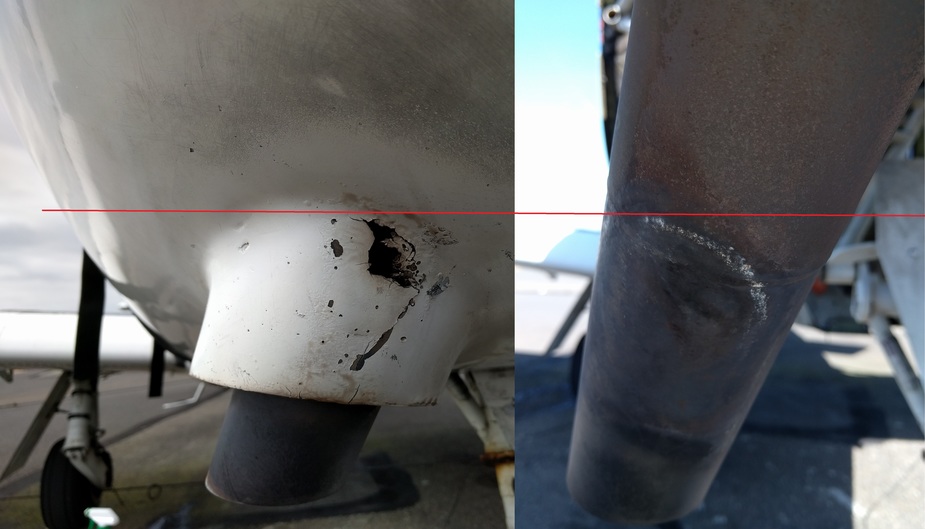I have the suspicion that the engine mounts are worn, and that this causes the engine to sag, and hence the exhaust stack to touch the inner cowling cut out. There is no exhaust leak visible, but there is a white line, that follows the curvature of the cowling. The white residue is possibly ash deposit from the burned epoxy.

Overlayed photo, not precisely to scale, but close enough, to see imprint.

Inside cowling. The black burned curve follows white imprint on exhaust stack.

How I believe the exhaust will move when engine mounts sag.
On the ground though the exhaust stack is centered. However, I found the following note from a follow owner:
“I had similar problem, exhaust touching the cowling in flight. Normally there was a clearance between the cowling and exhaust on the ground/stationary engine. But when I applied full power on T/O roll, the old, tired sagging rubber engine mounts allowed engine movement to the extent that the exhaust touched the lower cowling.”
How can I proof that the engine mounts are indeed worn out? They are 12 years old, and have 1900 hours on them, but look fine to my naïve eye. They are LORD mounts (J-9612-8 and J-7763-1). However, I added redlines to the engine mount photos, that show that the mounts have lost symmetry. But perhaps this is expected under load? Is it possible to tell, just by looking at the photos?
Looking for advice from engine mount experts.
Thank you!
Generally, rubber engine mounts will sag under the static weight of the engine as they reach the end of their life. Looking at the propeller spinner alignment to the cowling (from the side) is the typical way of assessing engine mount condition.
FYI the cowling looks to me like maybe its a chopper gun part with additional hand laid features added after the main shells were made. Chopper gun fabrication is the cheapest and fastest way to make a fiberglass part. The operator sprays fibers into the mold in a random fashion with lower quality resin. Its used for older type car bodies and thick boat hulls where high material strength isn’t required. I think any reasonable technique to repair the part will match the strength of the original.
Strange that it will sag under load isn’t it? I would think it would move the other way; sag when not under load, then pitch up when loaded. To me it seems like that is actually happening, or the hole would be on the other side.
Very interesting…
I would not expect the Lord mounts (or the Barry mounts which are also STCd for the TB20) to last 12 years without significant sagging.
Were yours really installed in 2004, and were they brand new then and not old stock at Tarbes?
Log book says, they were newly installed 2004. That’s all I know. How long did yours last, and which type are you using?
You can often see the sagging very good when looking at the forward part of the cowling at the starter flange / prop hub.
@Lucius It seems to me that you do have some exhaust leakage, not related to this issue though, the SCAT hose seems to have traces of a leaking exhaust, and the exhaust seems discolored. Maybe your exhaust is getting thin at that point.
I’m not familiar with the Socata mount but if the mounts need replacement after 12 years that would seem a bit unusual to me. For comparison I’m looking at a 2004 Diamond DA-40 with Lycoming power as I write. The spinner position is slightly above nominal in relation to the cowling, which would seem to indicate no sagging. They haven’t been replaced and the plane/engine has about 1100 total time. My plane is similar, I think the mounts have been replaced once in 45 years. FWIW.
Silvaire wrote:
the mounts need replacement after 12 years that would seem a bit unusual
I have regular LORD mounts. They are used by many airplanes. If you read through the comments at beechtalk.com, you see that most replace them before 12 years for various reasons, such as sagging or vibration.
Beechcraft typically installs engines like like this, using Continental engines installed on a bed, which loads the mounts in a totally different way.

I’d suggest that experience with Lycoming engines cantilevered from a tubular mount might be more applicable. If inspection of the spinner to cowling clearance shows no engine sag and the rubber isn’t cracked, I think the mounts are probably OK.